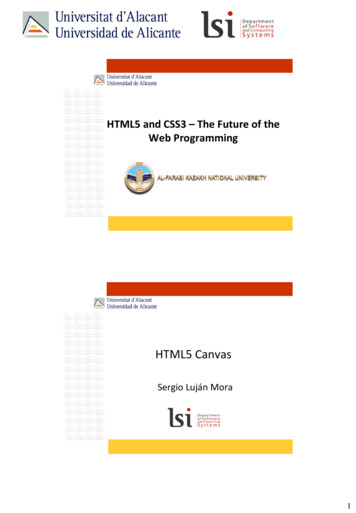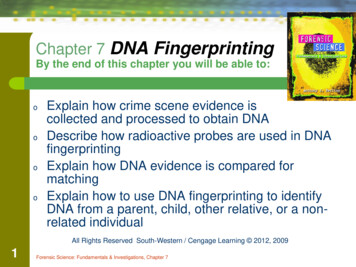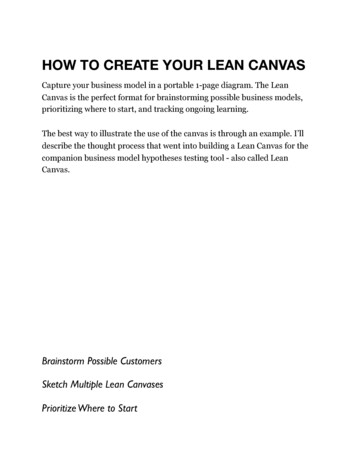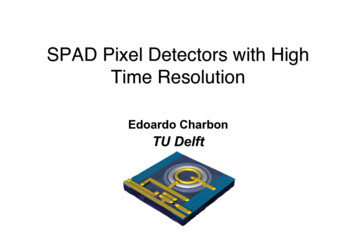
Transcription
Pixel Perfect: Fingerprinting Canvas in HTML5Keaton Mowery and Hovav ShachamDepartment of Computer Science and EngineeringUniversity of California, San DiegoLa Jolla, California, USAABSTRACTwe focus on, has privacy implications: different behavior canbe used to distinguish systems, and thereby fingerprint thepeople using them.Tying the browser more closely to operating system functionality and system hardware means that websites havemore access to these resources, and that browser behaviorvaries depending on the behavior of these resources.We propose a new system fingerprint, inspired by the observation above: render text and WebGL scenes to a canvas element, then examine the pixels produced. The newfingerprint is consistent, high-entropy, orthogonal to otherfingerprints, transparent to the user, and readily obtainable.1.Our results.We exhibit a new system fingerprint based on browser fontand WebGL rendering. To obtain this fingerprint, a websiterenders text and WebGL scenes to a canvas element, thenexamines the pixels produced. Different systems producedifferent output, and therefore different fingerprints. Evenvery simple tests — such as rendering a single sentence in awidely distributed system font — produce surprising variation. The new fingerprint has several desirable properties:INTRODUCTIONBrowsers are becoming increasingly sophisticated application platforms, taking on more of the functionality traditionally provided by an operating system. Much of this increasing sophistication is driven by the HTML5 suite of specifications, which make provisions for a programmatic drawingsurface ( canvas ), three-dimensional graphics (WebGL),a structured client-side datastore, geolocation services, theability to manipulate browser history and the browser cache,audio and video playback, and more.The natural way for browsers to implement such featuresis to draw on the host operating system and hardware. Usingthe GPU for 3D graphics (and even for 2D graphics compositing1 ) provides substantial performance improvements,as well as battery savings on mobile devices. And usingthe operating system’s font-rendering code for text meansthat browsers automatically display text in a way that isoptimized for the display and consistent with the user’s expectations.2This paper proceeds from the following simple observation: Tying the browser more closely to operating systemfunctionality and system hardware means that websites havemore access to these resources, and that browser behaviorvaries depending on the behavior of these resources. Thefirst part of this observation has security implications: codebases not designed to handle adversarial input can now beexposed to it.3 The second part of the observation, which It is consistent. In our experiments, we obtain pixelidentical results in independent trials from the sameuser. It is high-entropy. In 294 experiments on Amazon’sMechanical Turk, we observed 116 unique fingerprintvalues, for a sample entropy of 5.73 bits. This is soeven though the user population in our experimentsexhibits little variation in browser and OS. It is orthogonal to other fingerprints. Our fingerprintmeasures graphics driver and GPU model, which is independent of other possible fingerprints discussed below. It is transparent to the user. Our tests can be performed, offscreen, in a fraction of a second. There isno indication, visual or otherwise, that the user’s system is being fingerprinted. It is readily obtainable. Any website that runs JavaScript on the user’s browser can fingerprint its rendering behavior; no access is needed besides what isprovided by the usual web attacker model.Our fingerprint can be used as a black box or as a whitebox. A website could render tests to a canvas , extract theresulting pixmap, then use a cryptographic hash to obtaina short, convenient fingerprint. Because the fingerprint isconsistent, the pixmap (and therefore its hash) will be identical in multiple runs on one machine, but take on differentvalues depending on hardware and software configuration.This is a black-box use of the fingerprint, since it extracts1For example, IE9 uses the GPU for compositing, and recentreleases of Chrome use the GPU to accelerate 2D operationson the canvas.2By contrast, the first release of Safari for Windows imported font rendering code from Mac OS X, which offendedsome users; see l.3Indeed, one test in the WebGL conformance suite inducesa hard system crash on many systems [8]; and the TrueTypefont handling code in Windows and OS X, which is exposedto attackers by the WebFont specification, was patched to fixan exploitable parsing vulnerability as recently as Decemberof last year [13, 4].1
distinguishing entropy without being concerned with the implementation details.Alternatively, a website could use a particular test pixmapas evidence that a user is running some particular configuration of browser, operating system, graphics driver, GPU,and, perhaps, display. To identify a user system, the sitecan compare the pixmap it produces against a labeled corpus, such as the corpus we obtained using Mechanical Turk.An intriguing possibility is that GPU quirks could be usedto identify a pixmap without comparing against a corpus.However it is performed, such a white-box use of our fingerprint in this way reveals private information about users’systems.4 It could also be used to target an attack moreprecisely, by identifying specific vulnerable system configurations. Trying to exploit only those systems that appearlikely to be vulnerable could reduce the number of crashescaused by the attack, and therefore the likelihood that it isdetected by the operating system vendor.Fingerprints on the web have constructive and destructiveuses [14]. A use is constructive if users benefit from beingfingerprinted. For example, a bank could fingerprint a user’smachine, then require additional authentication for login attempts from systems whose fingerprint does not match. Ause is destructive if users do not benefit from being tracked,or do not wish to be tracked. Users can attempt to avoidtracking by using their browsers’ “private browsing” modes [1]or the Tor anonymity service [5].Users of Tor may be willing to endure a slower, less attractive browsing experience to avoid being tracked. (Notethat, although Torbutton disables WebGL, it allows textrendering to a canvas , and is thus at present partly vulnerable to our fingerprint.) For mainstream browser users,however, the possibility of fingerprinting might be an unavoidable consequence of browsers’ closer ties to operatingsystem functionality and system hardware.leakage from GPU-based rendering. In addition, we showthat there is substantial information leakage from font rendering to canvas .Many other researchers have proposed techniques to fingerprint web users. These techniques rely on many browserfeatures, including the history and file cache [11], information in HTTP headers and available plugins [12, 6], differences in JavaScript and DOM API support [7], JavaScriptperformance [14], available fonts [3], and deviations fromJavaScript standards conformance [16].2.HTML5 AND CSS3In this section, we introduce the emerging web technologies used in our experiments. First, we present informationabout the canvas element, a major portion of what istermed HTML55 , along with its support for text rendering. Next, we examine WebFonts, part of the CSS3 specification6 . Lastly, we briefly discuss WebGL, an experimental specification7 currently managed by the Khronos Group(which also maintains the OpenGL specification).These three specifications are not finalized, and so couldchange in ways that benefit or hinder fingerprinting success.However, our fingerprinting mechanisms use extremely basic features of these platforms, such as rendering text andinspecting pixels — removal of these features would be dramatic indeed.2.1HTML5 CanvasOne of the most interesting new elements in HTML5, canvas provides an area of the screen which can be drawnupon programmatically. It enjoys widespread support, being available in the most recent versions of Chrome, Firefox,Internet Explorer, Opera, and Safari as well as Mobile Safariand Android Browser.The basic approach to drawing on a canvas is simple: acquire a graphics context, and use the context’s API to effectyour changes. In the current HTML5 specification, the onlydefined context is “2d”. The 2d context provides basic drawing primitives such as fillRect, lineTo, and arc, as wellas more complicated features such as Bézier curves, colorgradients, and copying in an existing image.Related work: Fingerprints on the web.The earliest mentions known to us of using differences inGPU rendering to fingerprint users are in 2010 discussions onthe WebGL mailing list about whether the WebGL rendererinformation available to JavaScript should provide information about the GPU and driver. Steve Baker argued [2] thatit is possible to identify a GPU without this information: “Ibet that if I wrote code to read back every glGet result andbuilt up a database of the results - and wrote code to timethings like vertex texture performance - then I bet I couldidentify most hardware fairly accurately.” Benoit Jacob laterobserved [10] that2.1.1Canvas TextWe chose to focus on the text support found in the 2d context. Given a font size, family, and baseline, the 2d contextcan draw any arbitrary text string to the canvas. No wrapping is performed; the 2d context will happily draw textdirectly off the edge of the canvas. Lastly, canvas supports CSS-like text styling, allowing for any combination offont and size. For an example of how text is rendered, seeFigure 1.We haven’t yet started accounting for GPU rendering analysis (not just WebGL: in the upcoming generation of browsers, most rendering goesthrough the GPU and is subject to GPU/driver/config-based rendering differences.2.1.2Pixel ExtractionJacob also suggests the fingerprinting approach we take:“Rendering analysis could proceed by rendering stuff intoa canvas 2D and getting its ImageData.” One way to viewour research is as demonstrating experimentally that Bakerand Jacob were correct in expecting substantial additionalIn order for canvas to be a useful fingerprint, there mustbe some way to examine its behavior. Fortunately, canvas makes this extremely easy, providing several ways to inspectits data with pixel //www.khronos.org/registry/webgl/specs/1.0/As evidence that such information is private, we note thatChrome knows a great deal about the graphics subsystem —see chrome://gpu — but does not expose this information toJavaScript.2
script type "text/javascript" var canvas document.getElementById("drawing");var context canvas.getContext("2d");context.font "18pt Arial";context.textBaseline "top";context.fillText("Hello, user.", 2, 2); /script Current WebGL implementations expose their functionality through a separate canvas context (which will eventually be named “webgl”). The WebGL API is too complex to describe here in sufficient detail, but is stylisticallysimilar to the desktop OpenGL API. It provides for vertex and fragment shaders, written in OpenGL Shading Language (GLSL), that, after compilation, run directly on thegraphics card. WebGL also provides for OpenGL-style textures, as well as different lighting primitives. More advancedtechniques, such as specular highlighting, bump mapping,and transparency, can be achieved through custom GLSLshaders.Figure 1: Render text on a canvasFirst, the 2d context provides the method getImageData().Given a rectangular region of the canvas, this method returns an ImageData object. Contained in this object are theRGBA values (as integers) for every pixel in the requestedregion.Second, the canvas object itself provides a toDataURL(type)method. When passed “image/png”, this method returns adata url consisting of the Base64 encoding of a PNG imagecontaining the entire contents of the canvas. As this is avery convenient canvas-level method, we used this approachto extract data in our experiments. During black-box useof these fingerprints, the test suite could simply hash thesedata URLs, thereby removing the need to upload entire images from each client.It is worthwhile to note that these methods do preserve thesame origin policy — if an image from a different origin hasbeen drawn on this canvas, they will throw a SecurityErrorexception instead of returning pixel data. Therefore, our canvas fingerprints must only contain image resourcesthat are under our control.2.22.4These new capabilities, while providing more and moreways for developers to produce interesting and useful webcontent, do come at a cost. For efficiency’s sake, inputs fromthe web are passed farther and farther down the softwarestack: for example, GLSL shaders are compiled directly fromweb pages and run on the graphics card, allowing arbitrarydata to pass between the JavaScript execution engine andthe kernel-level graphics driver. Other attack surfaces arepossible: malicious or misguided GLSL shaders can crash orhang the entire operating system on OSX and Windows XPor cause GPU resets on Windows 7[8].WebFonts, while appearing more innocent, can also bea security concern. Remote code execution vulnerabilitieswhile parsing TrueType fonts have been discovered in Windows[13], OSX, Debian, Red Hat, and iOS[4].While we do not use these exploits in this paper, we takeadvantage of the fact that these new web technologies, forefficiency’s sake, push untrusted web content deep into theoperating system stack. In our case, however, we simplyexamine the results of these operations, exposing differencesin implementation (however slight).WebFontsWebFonts, specified in CSS3, allow web designers to load afont face on-demand, rather than relying solely on the fontsinstalled on each client machine. To include a font, the webdesigner inserts a @font-face CSS rule with a src attributepointing to a font in an appropriate format. The browserthen downloads the font and makes it available for use onthe page. Fortunately for us, web fonts can be used whenwriting to a canvas as well.To include WebFonts, we depend on the WebFont Loader8 ,co-developed by Google and Typekit. With this library,WebFonts can be loaded solely through the use of JavaScript, and callbacks can be established for certain events(such as the font becoming available or, conversely, failingto load). By attaching our rendering to a successful load,we are guaranteed to use the correct font while writing tothe canvas.2.3Security Implications3.EXPERIMENTSIn this section, we discuss the tests that underly our fingerprinting scheme, as well as the support infrastructure webuilt in order to deliver the tests and inspect their results.We will also detail the process of fingerprint collection froma large number of disparate users on the web.3.1TestsFor our fingerprints, we use six tests: text arial, text arial px, text webfont, text webfont px, text nonsense,and webgl. Each test follows the same basic outline: rendertest data to a canvas and extract its contents as an encodedPNG.WebGLWebGL provides a JavaScript API for rendering 3D graphics in a canvas element. Modeled after OpenGL ES 2.0,WebGL is currently a draft specification and implementedand enabled in Chrome, Firefox, and Opera, as well as implemented but disabled in Safari. Each of these browsersprovides a hardware-accelerated implementation, using theinstalled graphics hardware to render each frame. To mitigate serious misbehaviour and crashes, all of these browsersenable WebGL only for a whitelisted set of graphics cardsand drivers.3.1.1Arial TextIn our first two tests, we render a short sentence in Arial,a font known for its ubiquity on the web. To exercise eachletterform, we use the pangram “How quickly daft jumpingzebras vex.”, along with some added punctuation.For text arial, the text is rendered to the canvas in 18ptArial. In text arial px, we change the font specificationto 20px Arial. The actual code for these two tests is almostidentical to the snippet in Figure 1 — complicated testsaren’t needed for fingerprinting!Example images produced by these two tests are shownin Figure font loader3
Figure 2: text arial (top) and text arial pxFigure 3: text webfont (top) and text webfont pxFigure 5: An example run of the webgl testFigure 4: text nonsense3.1.2tion (2,4,9). Placing our surface at z 10, we render thissimple tableau.A example, rendered on OS X 10.7.3 with Chrome 18 ona AMD Radeon HD 6490M, is shown in Figure 5.WebFont TextThese two tests are extremely similar to the Arial tests,with the added complexity of loading a new font from a webserver. In a more sophisticated or targeted fingerprint, thedelivered font could be carefully tuned by the fingerprinterto exercise corner cases in font loading.In our case, however, we use the WebFont Loader to load“Sirin Stencil” from the Google Web Fonts server9 . Onceit loads, we render the same pangram as in our Arial tests.For text webfont, the text is set in 12pt Sirin Stencil, whiletext webfont px uses 15px Sirin Stencil.Example images are shown in Figure 3.3.1.33.1.5Nonsense TextCode-wise, this test is nearly identical to the two Arialtests. However, instead of a valid font specification, we setthe 2d font specification to “not even a font spec in the slightest”. This exercises the fallback handling mechanisms in thebrowser: what does it do with an invalid font request? Thebrowser’s choice of fallback font, as well as its positioningand spacing, can be quite telling.Also, note that this behavior is also the fallback font handling mechanism for when the browser is presented with avalid font specification for an unavailable font. Using thistechnique, tests can be written to probe for the existence ofa particular font on target machines. If enough of these testsare run, the fingerprinter can derive a fairly comprehensivelist of the installed fonts on the target machine.An example output is shown in Figure 4.3.1.43.2InfrastructureIn general, web designers can depend on their sites rendering in a consistent manner across various browsers andoperating systems. Therefore, we expected that any fingerprintable differences will be subtle, perhaps not even visibleto a human observer.To view these trace differences, we built a small webappwhich can administer the tests and examine their results.Experiments are served as pure JavaScript, and results arecollected as data URL-encoded PNGs. Our framework thencompares these results as images, allowing it to group identical results and display pixel-level differences between thesegroups.We use two types of image comparison: pixel-level difference and difference maps. When constructing a pixellevel difference, the framework first creates a new image ofthe appropriate size. Then, each pixel’s color is set to thechannel-wise difference between the two images at that location. If this color is anything other than transparent pureblack (which indicates that there is no difference betweenthe two images at this pixel), we set the alpha value of thediffering pixel to 255, rendering it fully opaque. For difference maps, each pixel in the map is set to either white orWebGLwebgl is our only test whose code spans more than a fewlines. As WebGL scenes go, however, this scene is almostminimal. We create 200 polygons, approximating the hy22perbolic paraboloid z y2 x3 , with 3 y 3 and 3 x 3. Over this surface, we apply a single texture: a 512 by 512 pixel rasterized version of ISO 12233,the ISO standard for measuring lens resolution. Designedfor measuring sharpness and resolution in electronic stillpicture cameras, this texture contains many areas with highdetail. We then
2.1 HTML5 Canvas One of the most interesting new elements in HTML5, canvas provides an area of the screen which can be drawn upon programmatically. It enjoys widespread support, be-ing available in the most recent versions of Chrome, Firefox, Internet Explorer, Opera, and Safari as well as Mobile Safari and Android Browser.







